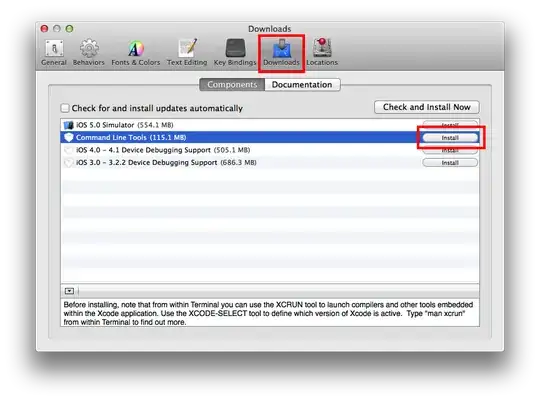I upgraded to OS X Mountain Lion and found out SVN is no longer present. I use Netbeans 6.9.1 in conjunction with Apache's SVN.
How can I get it back and working?
I upgraded to OS X Mountain Lion and found out SVN is no longer present. I use Netbeans 6.9.1 in conjunction with Apache's SVN.
How can I get it back and working?
Install the latest Xcode from the Mac App Store.
Go to Xcode » Preferences » Downloads » Command Line Tools » Install.

If you don't want to download/install Xcode, you can always just download Command Line Tools for Mountain Lion from Developer Downloads.
If you have Xcode installed and if you use bash :
$> vi ~/.profile
add this at the end of your .profile PATH="${PATH}:/Applications/Xcode.app/Contents/Developer/usr/bin/"
$> source ~/.profile
It should be working
Also checkout Homebrew for these type of packages :
brew install svn
XCode will only install SVN 1.6.18 (r1303927). But you can easily install Subversion from Apache. Just download the source files at http://subversion.apache.org/download/#recommended-release, unpack and go into Terminal. Navigate to the folder you just unpacked via
cd /path/to/folder
(you can drag & drop the folder from Finder into Terminal). Then type
./configure
wait
make
wait quite some time
sudo make install
However you might need to change your PATHS by going to /etc
cd /etc
and open the PATHS-File
open paths
In my case, the old installation was in /usr/bin/svn (you can check that with "which svn"), the new one is in /usr/local/bin. Both are in the PATHS-file, but in the "wrong" order.
You can also install the SVN and other command line tools without installing the full xcode as per this article:
http://blog.grapii.com/2012/08/svn-missing-in-mac-os-x-10-8-mountain-lion/
You can install one of the binary distributions available at
Apache Subversion Binary Packages - Mac OS X
I've chosen the WANdisco distribution myself. Keep in mind you need to stay on the same major version as Netbeans use, if you are touching your working copy from both NetBeans and the command line. So if NetBeans 6.9.1 is still using Subversion 1.6, you should go for Subversion 1.6.18, not 1.7.5. Or upgrade to a newer NetBeans version with Subversion 1.7 support.
Update: Looks like NetBeans svn support is interacting with the command line client, and supports svn 1.6.x and newer: Guided Tour of Subversion - Netbeans. I would go for the newest 1.7.x version then.
If you install through XCode you'll get svn 1.6.x. If you need 1.7.x you'll have issues with http urls of repositories so you'll need to install neon as well. This is my blog post about how to do this (the first part is why)
http://nemanjakovacevic.net/blog/2013/01/svn-android-pre-compiler-and-mac-os-x-pita-combination/
Currently there are many problems with svn 1.7.5 on Apple's Mountain Lion. The svn version of the Apache site has a wrong Neon version (causing svn: E170000: Unrecognized URL scheme for http*). The command line version of WANdisco has problems and is therefor not ready, while CollabNet does not have a build for OSX Mountain Lion.
The GUI version of Syncro is up-and-running for 1.7.5, command line versions are not.
The best is to stay on the 1.6 until all problems are solved.
It may be present in /opt/subversion/bin. If so, you can add that directory to the PATH environment variable in your ~/.bash_profile file.
SVN might already be installed but it may not be available in Terminal because SVN is not included in the path.
In 10.8, they moved SVN to the Application folder. You need to add this folder to the /etc/paths file so it is available in Terminal.
First, open nano:
sudo nano /etc/paths
Note that this will prompt for a password. Enter the correct password.
In the nano editor, add the following line at the end of the file:
/Applications/Xcode.app/Contents/Developer/usr/bin
Use Control + O to write the files and Control + X to exit Nano Editor.
Quit Terminal (Control + Q) and restart. Type SVN Help and you will see that SVN is now available in the Terminal window.
Here's some further help: http://www.threeeyedbird.com/blog/2012/08/06/where-did-svn-go-after-upgrading-to-os-x-mountain-lion-10.8/